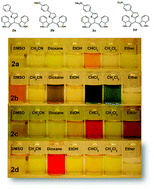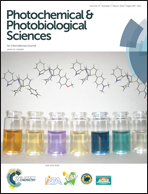Synthesis and solvatochromism studies of novel bis(indolyl)methanes bearing functionalized arylthiophene groups as new colored materials
Abstract
The demand for dyes with solvatochromic properties has increased in the last few years, mainly due to their wide range of applications in the analytical and industrial fields, such as in the textile industry. The phenomenon of solvatochromism is associated with the differential solvation of the ground and excited states of the solvatochromic compounds, leading to an important tool for the study of the nature of solute–solvent interactions. In this paper we report the synthesis of new bis(indolyl)methane derivatives bearing arylthiophene spacers (2a–d) functionalized with electron-donating and electron-withdrawing groups, and the photophysical studies in different solvents, such as ethanol, acetonitrile, dichloromethane, trichloromethane, dimethylsulfoxide, diethylether and 1,4-dioxane. Aiming to explore their solvatochromic behaviour in the ground and excited states, all solvents employed have different hydrogen-bond donor abilities. The largest colour modifications were visualized for compound 2b, the solution colours of which are orange in DMSO, blue in trichloromethane, green in dichloromethane and purple in 1,4-dioxane. A negative solvatochromism was observed in 2b and a positive one in 2a, 2c and 2d.


 Please wait while we load your content...
Please wait while we load your content...